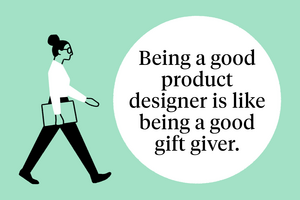Marketing Aug 1, 2024
Beware the “Bad-Influencer Effect”
Content creators’ self-indulgent posts may get “likes” on social media, but research shows they might not lead to more enduring connections.

Yevgenia Nayberg
To follow or not to follow—that is the question.
Or at least it is for the billions of people who scroll through social media each day. “Follow,” “friend,” “subscribe”—these clickable features underscore people’s ongoing urge to connect with others, even in a digital age.
And marketing managers and content creators bank on that urge, raking in over $30 billion globally per year from firms seeking to promote their products or brands on social media.
Connections are critical to social-media marketing because, by and large, people are more likely to accept the recommendations of those with whom they feel a connection. Even an imaginary relationship with a content creator online increases a person’s receptivity to product and brand recommendations, says Maferima Touré-Tillery, an associate professor of marketing at the Kellogg School.
“Naturally, people seem to be more open to the advice and recommendations of those with whom they feel connected, whether this feeling of connection is mutual or only one-sided,” she says.
Research by Touré-Tillery and coauthor Jessica Gamlin, a Kellogg alumna and an assistant professor of marketing at the University of Oregon, delivers insight that may help marketers and content creators ensure they are not missing out in the ongoing battle for these connections.
According to the new research, people are unlikely to connect with, or “follow,” a content creator who posts about being self-indulgent—by eating junk food or binge-watching TV, for example. The effect is especially pronounced among social-media users who believe that spending too much time looking at the indulgent behavior online might prevent them from hitting their personal goals. The researchers refer to this interaction as the “bad-influencer effect.”
“If I have a goal to be productive today, and I scroll past someone who’s talking about mindlessly watching Netflix, I’m probably not going to connect with them,” says Gamlin. “Instead, I’ll avoid socially connecting with them to try to get back on track with my goal to be productive.”
#Indulgence vs. #selfcontrol
Marketers and marketing scholars alike have long been interested in how to expand one’s social-media reach.
Recent studies have focused heavily on what drives engagement on social media, in the form of clicks, likes, comments, and retweets. They have shown that audiences like to engage with posts by content creators who are perceived as authentic, credible, warm, humorous, moral, or able to grab a consumers’ admiration or envy. When a person creates an Instagram post about indulging in unhealthy foods, for example, audiences often perceive that person as authentic and warm which, in turn, garners a high volume of “likes” and “shares.”
Less explored, however, is whether these drivers of engagement translate into connections on social media that endure beyond a fleeting tap of the screen.
To investigate this dynamic, Touré-Tillery and Gamlin turned to Instagram and, specifically, to posts that display some form of either indulgence or self-control. Their team culled information from the top-nine most popular posts for each of the hashtags #indulge, #indulgence, #selfcontrol, and #willpower, every day over a period of eleven days.
The content creators who used the hashtags #selfcontrol and #willpower had, on average, a significantly higher number of followers (73,989) than those who used the hashtags #indulge and #indulgence (8,666). In addition, a follow-up study of the top food influencers on Instagram showed that the more indulgent that viewers rated an influencer’s content to be, the fewer followers the influencer had.
“It’s become sort of a norm on social media to share both yourself at your best and also your indulgences, like posting photos from a fancy vacation that you spent all this money on,” Gamlin says. “Sharing those indulgences is widely seen as acceptable, it’s just that it could undermine social connection.”
Bad influencer
Though the findings suggested a negative correlation between posts about indulgence and connections on social media, they did not confirm a causal relationship. So the researchers decided to test this interaction in a more controlled environment.
They conducted several experimental tests to determine if the bad influencer effect was directly limiting content creators’ ability to get followers. For each study, the research team created a social-media persona to post content that exhibited indulgence or self-control. Then they randomly separated participants into two groups to view either the posts about indulgence or about self-control.
After looking through the posts, the participants answered questions about their willingness to connect with the social-media persona on a one-to-seven scale, where seven indicates the greatest willingness to connect.
In one of the studies, which included 232 users of X (formerly Twitter), people were less willing to connect with a persona who tweeted about binge-watching TV shows before bed (with an average willingness-to-connect rating of 3.49 out of seven) than when the persona tweeted about meditating before bed (3.83).
“If I have a goal to be productive today, and I scroll past someone who’s talking about mindlessly watching Netflix, I’m probably not going to connect with them.”
—
Jessica Gamlin
A similar result emerged on Facebook. In a pool of 201 participants, the group that saw the persona use curse words in their posts was less willing to accept a friend request (3.08) than the group that saw the same posts but with the curse words omitted (4.4).
The outcome was the same across five studies they conducted using various social-media platforms and featuring different kinds of indulgences.
What’s more, a follow-up study presented participants with a final social-media post in which the persona asked people to donate to a charitable organization. Participants least receptive to the recommendation were those who had seen the posts displaying indulgence. Collectively, the findings suggest that people are not only less willing to connect with others who offer a negative example but also less likely to be persuaded by them.
Engagement is not connection
Around the time Touré-Tillery and Gamlin were reviewing their findings, a study was published in the Journal of Marketing Research that appeared to come to the opposite conclusion.
“When I first saw the findings [of the other study], I thought, ‘Wow, this is almost exactly the opposite of what we’re finding,’” Gamlin says. “What they find is indulgent posts garner more likes, comments, and shares. What we’re finding is that those same kinds of posts garner fewer followers and connections.”
“But as I reflected more,” she continues, “I realized that it’s actually not the opposite, it’s an interesting nuance. The turning point for me was when I understood that viewing social-media engagement as just one monolith—likes, comments, follows, retweets all under the same umbrella—is just not enough.”
That is, the same social-media behaviors that spur engagement in the short term could be detrimental to fostering connection over the long term.
Aligning goals
But what was driving this negative interaction between indulgence and connections? Drawing from their past work, the researchers suspected that much of it was dictated by people’s goals.
Indeed, throughout their studies, they found evidence of a strong association between a participant’s commitment to a personal goal and their willingness to connect with a content creator.
One of their studies, for instance, found that participants who saw a social-media post about mindless TV-watching were less likely to follow the content creator if the participants themselves had a goal to be more mindful with their spare time. And the effect was amplified for participants who claimed to be highly committed to their goal.
The participants reported that following the TV-watching content creator, and potentially triggering similar posts to appear on their social-media feed, could have a negative impact on their own habits.
“Regardless of whether somebody on social media can be helpful or harmful to my goals, I may perceive or expect them to have a certain influence,” Gamlin says, “and my likelihood of connecting with them is really driven by that perception.”
When people saw a post that they thought might compromise their goal, they remained unwilling to form a connection even if they otherwise admired the content creator or found the posts to be funny.
“Whereas a like or a comment is a temporary thing, following someone on social media has long-term implications, which is why I believe it’s so connected to people’s goal pursuit,” Gamlin says. “The implications are really strong for brand managers and content creators, where a major strategic objective is growing your audience, and a good return on your social-media-marketing investment.”
Balance in all things
With their study’s findings in mind, Touré-Tillery and Gamlin offer several strategies to help marketing managers and content creators optimize their influence on social media.
To start, recognize the importance of consumer goals in audience-building and leverage social-media tools such as polls, quizzes, and surveys to understand those goals, they say.
“We cannot assume that every audience has the same goals for eating healthy or limiting TV consumption,” Gamlin says. “Some audiences have the opposite goal and want to eat delicious foods and watch TV as part of their self-care.”
“So, it’s important not to make blanket statements like, ‘These are people’s self-control goals, and these are people’s indulgence goals,’” she continues. “You have to actually survey your audience to understand them.”
Once those goals and the expectations surrounding them are clear, then influencers can create content that aligns with what their audience wants, while actively monitoring and tailoring the content and product offerings to make sure that they remain supportive of rather than aversive to people’s goals.
“We’ve just scratched the surface in understanding how people respond to others in online contexts,” Gamlin says. “If you’re a brand manager or content creator, you want to make sure that you remain true to yourself and authentic, but also remain true to your audience’s goals, avoiding indulgences that might alienate them.”
“Understanding the goals and aspirations of your target audience is at the core of segmentation and sound marketing practices, so well-managed firms should already have a solid understanding of their audience,” Touré-Tillery says. “Our research highlights an additional consideration for firms and content creators to help increase the size and long-term engagement of their online audiences.”
Abraham Kim is the senior research editor at Kellogg Insight.
Gamlin, Jessica, and Maferima Touré-Tillery. 2024. "The Bad-Influencer Effect: Indulgence Undermines Social Connection." Journal of the Academy of Marketing Science.



